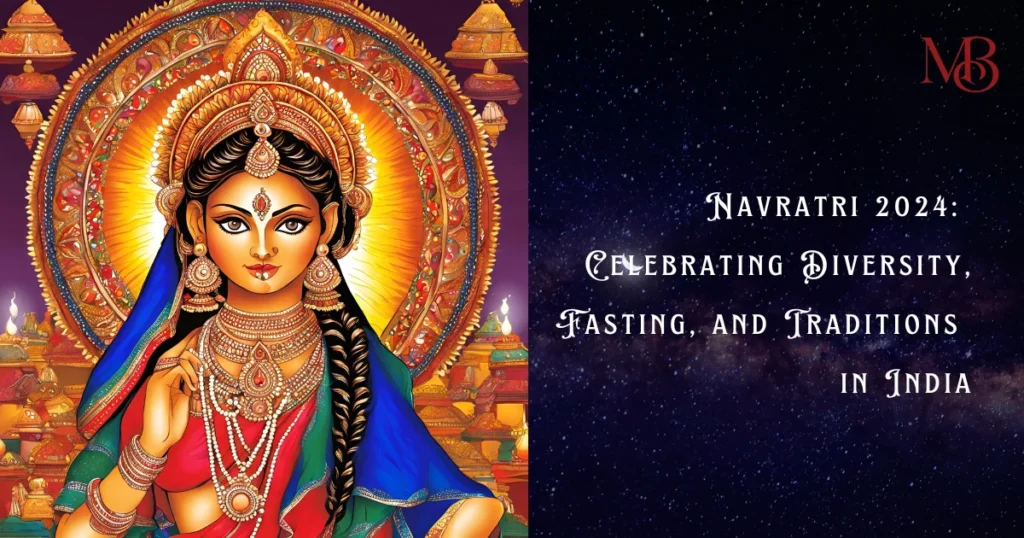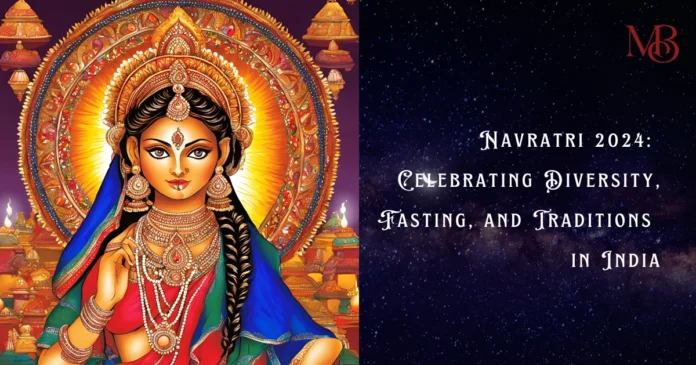Navratri is the most celebrated festival in India. It is spread over nine days and celebrates goddess Durga and her myriad avatars. However, though the essence of the festival is uniform all across, regional customs, fasting rituals, and celebrations vary widely. The article gives an insight into different aspects of Navratri-from celebrations to eco-friendly practices.
4 Unique ways of Navratri celebrations across India
While Navratri is a pan-Indian festival, the way people celebrate Navratri goes in myriad ways across states in India. Every region has its unique way of paying homage to the goddess, thus infusing spirituality into local culture.

1. Gujarat – Garba and Dandiya
At the mere mention of the word Gujarat, one gets prompted to think of Garba and Dandiya Raas. These folk dances are set against the backdrop of traditional dress and chawki or kerosene lanterns that light up the nights during Navratri. People gather in community centers and dance with devotional music at hand to show their devotion and celebrate unity.
2. Durga Puja, West Bengal
Overlapped Navratri in Bengal with Durga Puja that showcases magnificent pandals as temples to house the beautiful idols of Goddess Durga. Rituals, cultural events, and feasts characterize the festivities. The artistry behind the idols and pandals is peerless and thus attracts the attention of many tourists around the world.
3. South India – Golu Display
The Golu display is celebrated with Navratri in Tamil Nadu and Karnataka, where families keep dolls on a multi-tiered stand and each doll carries some importance. It represents gods, goddesses, and scenes of Indian mythology. People are invited to pray and share snacks, and many communities arrange cultural events during such celebrations.
4. Maharashtra – Watching with Functions
In Maharashtra, Navratri is more of prayer and fasting. People go to temple and there are community functions on a large scale during this festival, which are all devotional in nature. The Dussehra that is celebrated on the tenth day of the festival is a grand affair with much fervour, signifying the victory of good over evil.
4 Tips for Fasting on Navratri
Fasting for Navratri is not just abstaining from food but also detoxifying the body. A harmonic diet while fasting will keep you energized for the festival.
1. Hydration: Most people fast for hours, so hydration is a necessary factor. The flow of water, coconut water, and herbal teas in the body will maintain your energy levels.
2. Favor Sattvik Food: Pure, light, and easy to digest foods are preferred. Meals can be prepared with different ingredients such as buckwheat flour (kuttu), water chestnut flour (singhara), and amaranth (rajgira) along with kuttu ki puri, singhara halwa, and rajgira paratha .
3. Avoid Fried Foods: Though most of the people consume fried foods during Navratri, it is better to substitute it with roasted or steamed food for healthier options.
4. Add Fruits and Yogurt: Fruits constitute a significant constituent of the fasting diet and can contribute natural sugars. Yogurt maintains the health of the gut and has a cooling effect.
Meaning of Colors in Navratri
Navratri is also celebrated with the symbolism of colors when one day is dedicated to a specific hue that represents the different manifestations of the goddess.
1. Day 1 (Yellow): This bright color represents herewith happiness and this day one will start Navratri positively.
2. Day 2 (Green): Green indicates growth and renewal shows the nourishing property of the goddess.
3. Day 3 (Grey): Grey represents strength and transformation and symbolizes how the goddess removes evil.
4. Day 4 (Orange): The symbolic color of energy and warmth, this color represents a goddess who is fierce yet compassionate.
5. Day 5 (White): White is a color of purity, peace, and meditation. It is thought to be the color of Goddess Saraswati
6. Day 6 (Red): Color of bravery and action, red is an indicator of the relation with fierce form of Durga
7. Day 7 (Blue): Blue comes as an indicator of immense power and divine energy, marking Goddess Kali
8. Day 8 (Pink): The color of love and compassion, pink is the portrayal of the softer aspect of the goddess.
9. Day 9 (Purple): It is a royal color of ambition and victory; it was the last day of the festival with feelings of accomplishment.
You might also like: 7 Essential Parts of Travel Planning
4 Travel Destinations to Experience the Best Navratri Celebrations
To experience Navratri to its fullest, visit such places to make your experience worthwhile.
1. Vadodara, Gujarat
Voted as the cultural capital of Gujarat, this is a place from where one can spot some of the most elaborative Garba events going on in India. It is a haven for dance lovers who want to experience the authentic flavor of the festival.
2. Kolkata, West Bengal
The extravagance of Durga Puja in Kolkata can never be equated with any place. This city has turned out to be an epicenter of arts and culture in its own way with artistically designed pandals and colorful processions; it attracts and attracts visitors from all corners of the globe.
3. Mysore, Karnataka
One of the most magnificent celebrations of Dussehra takes place in Mysore. Caparisoned elephants, lively music, and cultural performances mark its great procession. The splendor of the day illuminates the Mysore Palace, infusing festivity into the air.
4. Mumbai, Maharashtra
Mumbai is very famous for a combination of devotion and frolic during Navratri. The city has great Garba events and people throng the temples for worship and rituals.
4 Eco-Friendly Ways to Celebrate Navratri and Dussehra
As people have become more aware about the environment, most people have adopted this green trend in the celebration of Navratri.
1. Use Biodegradable Decorations
Instead of using plastic-decorated lights, wall hangings, and other balloons, one can use flowers, leaves, and clay-based decorations. This will also be non-harmful for the environment after the celebration.
2. Eco-Friendly Idols
Utilize idols made from clay or biodegradable materials that dissolve in water instead of idols made from harmful chemicals that would not contaminate it.
3. Reduce Noise Pollution
Do not disturb the environment and your neighbors by holding the celebrations without using too many loudspeakers and firecrackers.
4. Reusable Fabrics and Materials for Costumes and Decorations
Minimize carbon footprints from festivals by using sustainable or reusable materials for costumes and decorations.
You might also like: 10 Strange Traditions Around the World
Navratri is a festival of culture, devotion and unison. The festival hosts traditions ranging in various distinct ways across different regions, the worth of fasting, a lot spiritually. On such an occasion while observing navratri we can also take a step for ensuring that our practices are also eco-friendly. Embracing these traditions along with new habits and remaining eco-friendly turns Navratri from being a festival simply of devotion to becoming a festival of sustainability, too. Follow our culture page for more updates.


